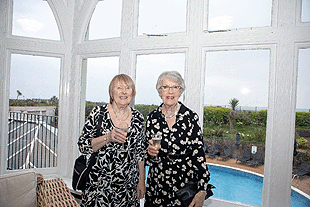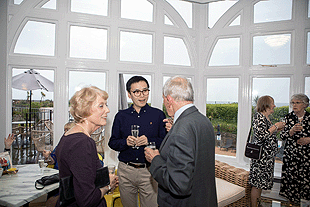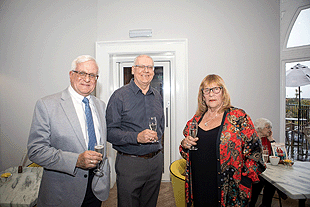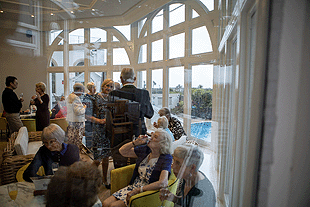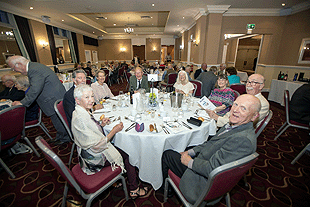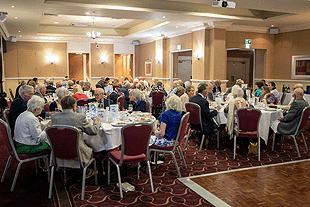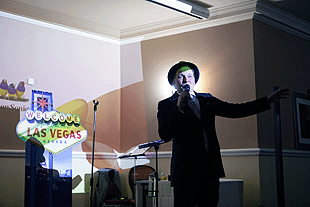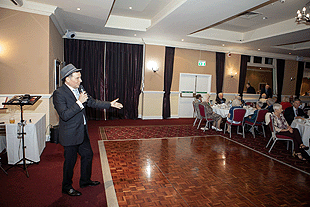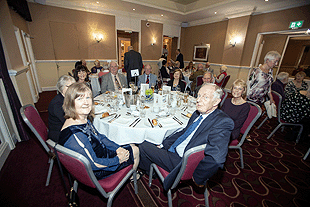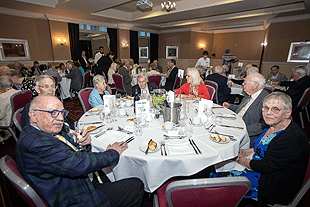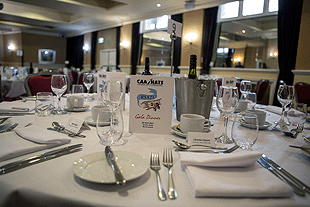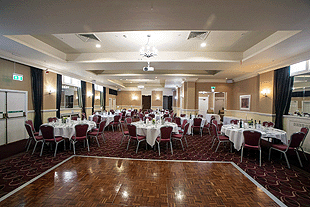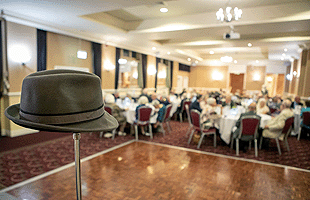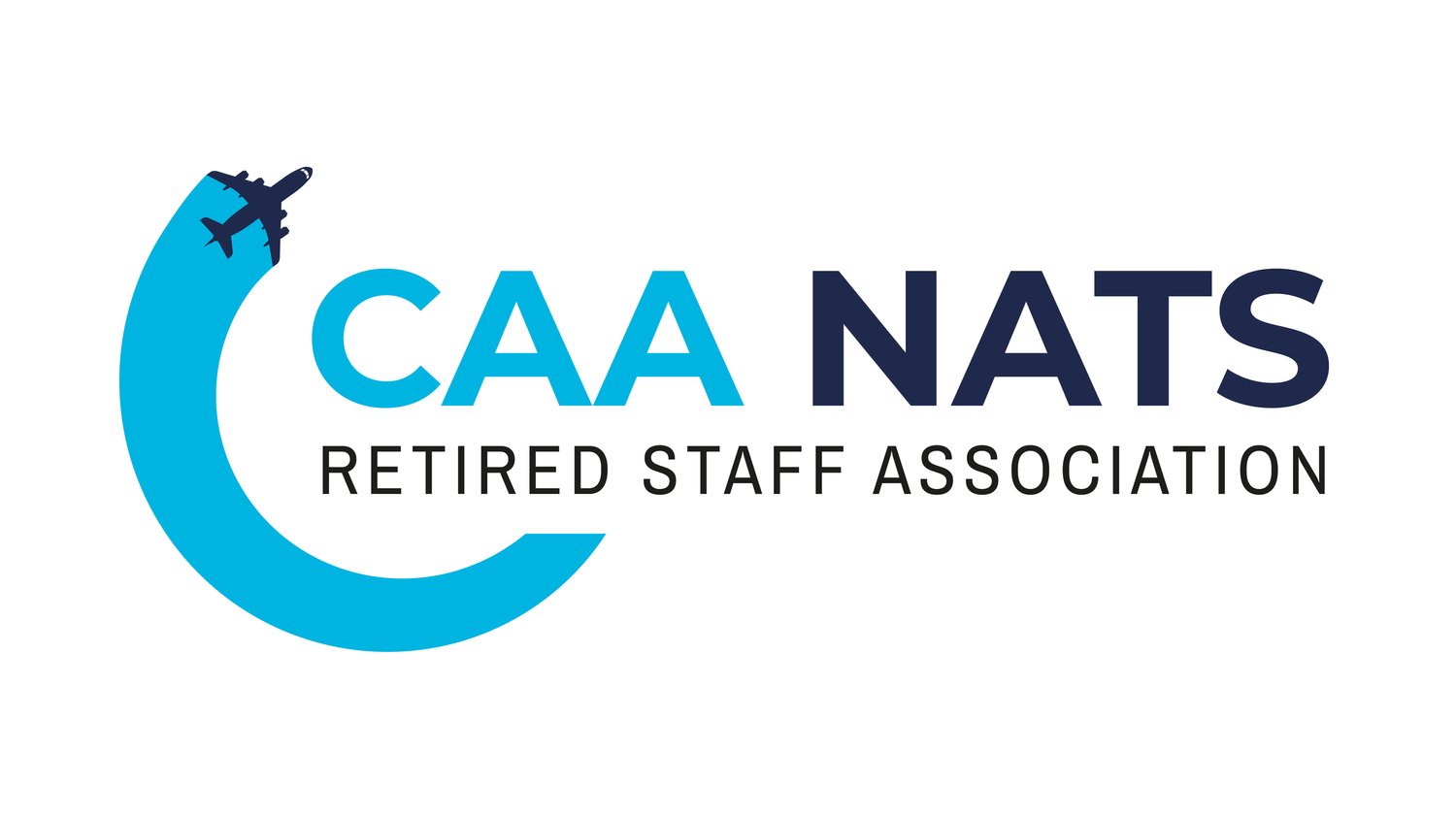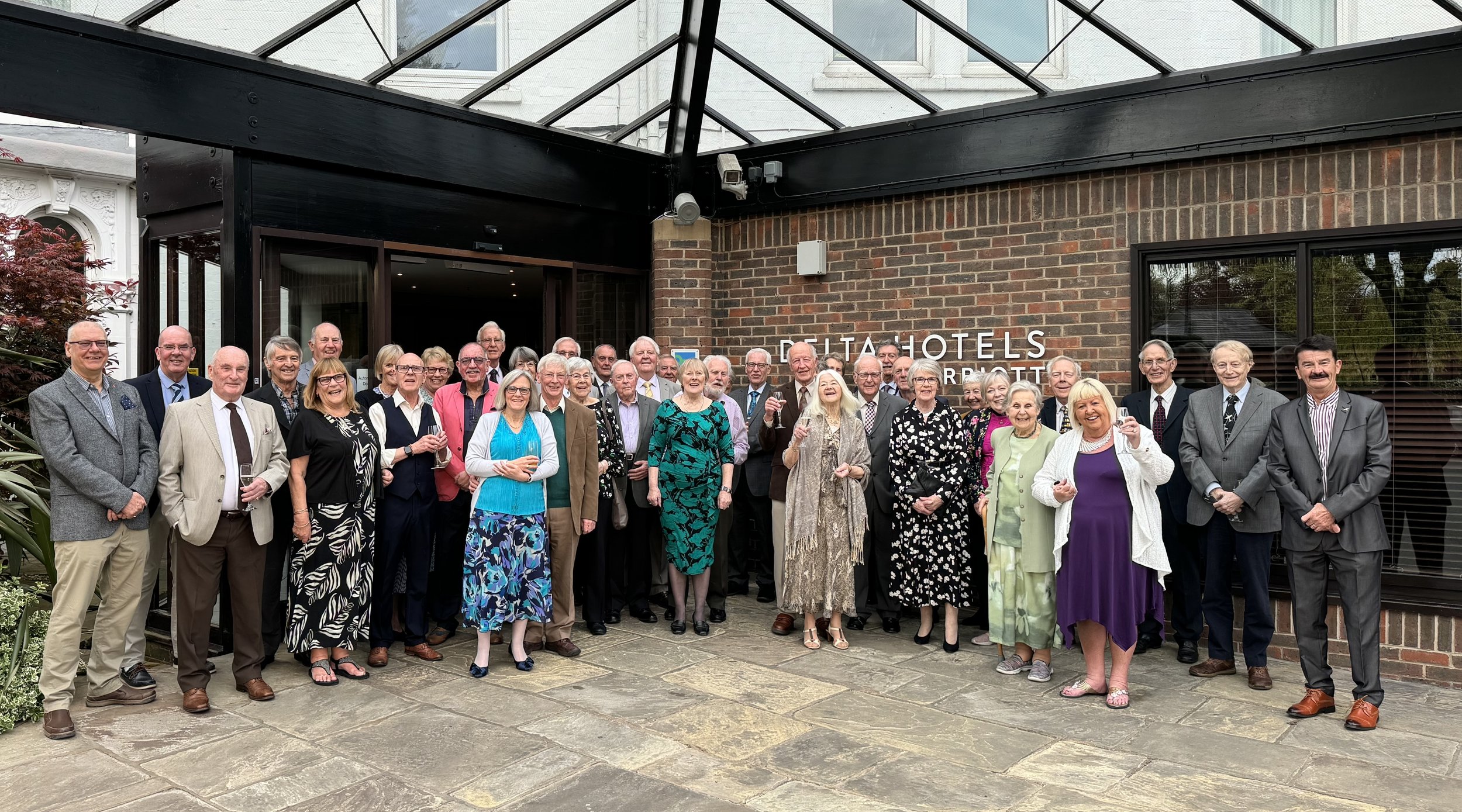
AGM
RSA 26 Shrewsbury
24-25th April 2026
AGM
& GALA WEEK-END
Mercure Albrighton Hotel
SATURDAY TOUR PROGRAMME
OPTION 1, free
AM - Visit the RAF Museum Midlands (RAF Cosford)
PM – Explore Shrewsbury on foot at your leisure
OPTION 2, free
AM - Take a short river cruise and then join our private guided walking tour to see some of Shrewsbury’s historic sights
PM - Explore more of Shrewsbury at your leisure.
OPTION 3
None of the above, thank you, I’ll make my own arrangements.
(There is a lot to see by car locally - Ironbridge and gorge, Blists Victorian Town etc.)
Full details and booking form in September 2025 Contrail.
You can also book on line by using the form
New for 2026 we are able to offer an early booking discount.
RSA 25 Salisbury
25-26th April 2025
AGENDA & REPORTS FOR THE AGM CAN BE FOUND ON THE COMMITTEE DOCUMENT PAGE
A report on the gala weekend events
by
Richard Wright
RSA 25 –
and the dragon who came to dinner
Well, I hope that was a ‘read-on’ headline for you? I was going to call the report “…and the cathedral that moved” but that felt a bit tame by comparison. So please read on to see what I’m talking about whilst I recount the weekend:
RSA 25, our AGM Meeting and Social Weekend was based in the very agreeable surroundings of the Milford Hall Hotel, in the centre of the historic city of Salisbury – a venue found for us by our event organisers Paul Clayton and Chris Whichello. What a great place to stay, so a big thank-you to Paul and Chris.
Our weekend began with the AGM on Friday afternoon, and it appeared that several attendees - including me - had had ‘challenging’ journeys with cancelled trains or blocked roads. Happily, I’d arrived just in time to join some other RSA friends in the bar before the meeting (surely not? Ed).
I’m sure that there will be a full AGM report elsewhere in this issue, but my understanding is this:
This year’s AGM was particularly important for the RSA for three reasons: we’ve lost several branches over the last few years because they couldn’t get volunteers to fill the required official roles for the branch so they had to suspend operations. Secondly, because we need – after many years – to resolve the conflict between members who pay (or don’t pay) to belong to the RSA. Lastly – and perhaps more controversially – to complete the move towards on-line communications with RSA members. All these topics have been debated at length at Central Committee level, all branches have been consulted and many hundreds of individual members have been invited to comment.
RSA chair Andy Maynard explained that: (1) simplifying branch constitutions would make it easier for groups of RSA members to organise local events with fewer branch officers: (2) that it was now some 15 years since RSA was obliged to introduce subscriptions following the withdrawal of CAA and NATS funding and that it was no longer appropriate for non-paying members to enjoy the same benefits as their paying colleagues and: (3) that communications - including ‘Contrail’ – would transfer to digital-only over the next 18 months. Andy explained that there would be on-going safeguards for RSA members without on-line access. All the AGM motions were ‘carried’ by members (mostly unanimously, with a couple of abstentions and (as I recall) only one vote against.
So, where does that leave us? We live in changing times, don’t we? When RSA was established more than 40 years ago, most retirees wanted to remain in contact with their former work-mates, but now they have more independent social arrangements and are – perhaps - less interested in former colleagues. Like it or not, that’s the way it is and the RSA needs to evolve to remain relevant. The changes introduced at the AGM will help that aim.
At the AGM, Colin Chisholm, our long-standing Pensions Rep (and former Trustee) retired from the Central Committee. Chairman Andy thanked him for his service and he was warmly applauded. I know that when an MP retires they usually say that they’ll be “spending more time with their family.” I have this little nagging thought that Colin might just be spending more time with his golf clubs…. Anyway, I’ve been appointed to succeed Colin as your Pensions Rep and I have to tell you that he’s left some pretty big shoes to fill! I’ll do my best!
In the evening, we settled down to drinks followed by an excellent buffet supper and there was a steady hum of conversation as members caught up with one another. Later during our meal, some of us were introduced to what must be one of the most unusual guests in RSA history – a very large lizard called Falkor, who happens to be the pet of the hotel’s receptionist Sophie. “She’s actually a bearded dragon,” her owner told me, “and she’s a real attention queen. She loves it when my daughters take her to the shops and she gets petted by the children.” Well, Falkor seemed to appreciate the RSA members she met over dinner and I hope that she returned home happily. Does meeting a dragon beat moving a cathedral? That’s another read-on!
On Saturday morning we divided into groups: some members enjoying Salisbury in their own way; others went on a guided walking tour of the city, and I joined the coach for a short journey to tour the Boscombe Down Aviation Collection, which is based at Old Sarum Airfield.
RSA member Phil Holt (thank-you Phil) explained that Old Sarum is the oldest military airfield in the world, having been a base for the Royal Balloon Corps before being repurposed for the Royal Flying Corps during the First World War. Nowadays, there are some private aircraft based there, and a parachute-jumping club, but the airfield is probably better known for being the home of several ‘Belfast’ aircraft hangars, all of which are listed Grade 2* (meaning they’re very very rare and important).
Tech-y bit – but you can skip this – Belfast hangars get their name from an ingenious set of criss-cross wooden trusses that support a wide roof-span without requiring intermediate floor supports – thus providing a completely unobstructed space within the hangar walls. The company that made them (and patented the design) was based in…. Belfast. OK? Now back to the story.
The Boscombe Down Aviation Collection occupies two of the ‘Belfast’ hangars and is focused on aircraft and equipment that had – at some point - been used at Boscombe Down Airfield, home (for many years) of the Aircraft Evaluation Unit and the Empire Test Pilots’ School. Unlike most museums (which they insist it isn’t), BDAC operate a ‘hands-on’ policy so that you can climb into aircraft cockpits and touch exhibits. Besides our RSA members reflecting on past adventures I’m happy to report there were many parents visiting with young children who were – in some instances – screaming with pleasure at pulling heavy levers to make things move. If you’re ever worried about your grandchildren spending too much time on their phones, bring them here: they’ll have a great day out – and so will you.
As we left Old Sarum, we passed the huge Iron-age hill-fort that gives the area its name. Back in the day there had been a castle and a cathedral within the defensive rings of the fort. As it happens, I’m a sucker for place names and I noticed a road-sign for the hamlet of “Stratford-sub-Castle” nestled just behind the fort. Doesn’t that just tell you everything you want to know? Very satisfying for us nerds!
Back in Salisbury I caught up with some of the guided walkers, who introduced me to the network of medieval streets around the market-place in the old town. Some of the streets still bear the names of their original functions: Ox Row, Salt Lane, Oatmeal Lane, Hog Lane and The Poultry Cross, all used as trading places. It doesn’t take too much thought to understand, does it?
But I wondered about how and why the Salisbury (New Sarum if we’re being picky..) we know today had originated, and what had happened to the castle and cathedral on the hilltop at Old Sarum. After all, a cathedral barely 200 years old is still almost ‘one owner from new’ in church terms. This is what I discovered:
The hill-top fort at Old Sarum was easily defensible and the Saxons beat off attacks from the Britons and then the Danes. It’s mentioned in the ‘Anglo-Saxon Chronicle’ (an important book but not anywhere in Amazon’s best-seller list by-the-way) and became an important town as a result. A Norman bishop (Saint Osmund) built a castle and cathedral, but then he fell out with King Stephen – who promptly confiscated the castle. For the next 200 years the monks argued with the castellians (is that a word? Ed) about the amount of water they could draw off to make the mead which they needed to sell to fund their religious activities. And they didn’t like the constant hilltop winds, either. (This isn’t going to end well. Ed)
Eventually, in the 1200s the Bishop and his monks agreed they had to move and (legend has it) employed an archer to fire an arrow into the distance, and they would build a new cathedral wherever the arrow fell. The arrow lodged in the flank of a deer that ran a couple of miles before collapsing on the flat meadows beside the river. The Pope of the day (Honorius 3rd, should you ask…) wrote in 1219 ‘Let us descend joyfully to the plains, where the valley abounds in corn and there is freedom from persecution’.
And there, dear reader, is where Salisbury Cathedral stands today.
I went to the cathedral and, unlike most British cathedrals, Salisbury was built in a single style (Early English Gothic – but I guess you know that) so it has a wonderful sense of cohesion. Work started in 1220 and was largely completed by 1270, with the amazing spire (Europe’s tallest medieval structure at 404 feet) completed 50 years later. If you want to get a sense of how daring/challenging that building was, I recommend William Golding’s ‘The Spire’. I’ve read it so often that my copy is falling to bits.
And then in the cathedral cloisters, there are two video-loops: one is of the climbers who ascend the spire (inside) and then open a hatch near the summit, to ascend outside to climb the remaining 50 or so feet to keep the hazard lights functioning. If you don’t like heights then DO NOT watch this video. The second feed is from the nest of a family of peregrine falcons nesting on a ledge at the top of the tower. How good is that? Well worth a look.
But one of the things that impresses me about Salisbury Cathedral is its efforts to remain relevant to today’s congregation (and I don’t mean ‘woke’, whatever that is): Salisbury was the first Cathedral to employ a girls’ choir (in 1991) alongside the traditional boy choristers, and the church furnishings include a superb water-fountain font in the nave, and a modern altar with contemporary stained glass referencing modern martyrs.
I walked back to our hotel visiting the church of St Thomas & St Edmund, which was built as a place of worship for the craftsmen who were building the new cathedral. Its wonderful ‘Doom’ painting was surely a source of inspiration (or fear) for the medieval stonemasons, and for the centuries of visitors who follow.
So, whilst Salisbury is very much a ‘church-inspired’ and influenced town, it has developed so many links that today, it is an important regional trading town – and a great place to visit.
In the evening we assembled for drinks before our Gala Dinner. I’ve been to many of these functions before and I’d like to report that the Milford Hall staff were absolutely the best I’ve come across over the years. Thank you – and thanks also to Paul and Chris for guiding us to such a great weekend.
I returned home on the Sunday, although I know that some of our members stayed on. What did I take away from our RSA 25 weekend?
RSA is entering a new - streamlined – phase. We’re here for all of you, but you need to recognise that it costs us to look after you, whether you attend our events or not. Working with the people who pay your pensions is our business. Think about it!
RSA 24 York
26-27th April 2024
A report by Richard Wright
York – what a great place to hold an AGM and social weekend! My first thought was “I want to be there – but how do I get there?” Let me start with a confession: I love cars and I love driving. Less keen on roadworks and other traffic delays, but still pretty positive so far… Oh, and I know the M1 quite well having driven up and down it many times with consignments of gold to the Assay Office in Sheffield – but that’s a story for another time…
But I know the East Coast mainline pretty well as well, having travelled up to Yorkshire many times for meetings at the firm I worked for after leaving NATS. On one occasion I was startled to see a GWR ‘Castle Class’ steam locomotive painted maroon. They were always Brunswick Green, I thought. Then I saw the nameplate “Hogwarts Castle”. If you have grandchildren you’ll know the rest!
Complicating the ‘how?’ issue was the London Emissions Zone charge – and here’s something which baffles me still today: my most economical (and least polluting) car isn’t ULEZ compliant, whilst my thirstiest (and most polluting) is. I’ve asked Transport for London to explain, but if you know TfL like I do, you won’t be holding your breath for an answer!
So, should I buy less petrol and pay £25 in emissions charges, or buy huge amounts of fuel (OPEC countries love people like me…) and wreck the planet whilst travelling fee-free?
In the end, I let the train take the strain, not least because it’s so easy to book on-line and advance-booking discounts are huge. Then dilemma number two: King’s Cross to York - LNER (main operator) or Grand Central (plucky outsider)? In the end I went north with LNER and returned south with Grand Central. Now it won’t have escaped your notice that our railways are in a mess – and that Labour has promised to renationalise them if they win the next election. In fact several big train operators (including LNER) are being run by the Department for Transport already, the commercial companies having over-bid for the right to operate trains and then ‘handed in their ticket’ after sustaining huge financial losses.
So, how did they compare? Well, it’s popular to think that the world is going backwards, but consider this: both ways, I was travelling on a quiet, economical, smooth, air-conditioned train that tilted around corners (so my G&T didn’t slide off the table) whilst looking out over medieval churches and ‘ridge & furrow’ field systems. In my mind, that’s definitely progress! The LNER train was newer and the service was excellent, but the Grand Central team were just lovely - the sort of people you’d want as friends. Winners both, I think.
George Hudson (aka The Railway King) was Chief Engineer of the East Coast mainline – and like most early railways it was designed to move freight, not passengers. The York station we see today was built some 30 years later by architect Thomas Prosser and features a series of magnificent iron arches covering the platforms, all built on a curve (It was a bit of a ‘how did they do that?’ moment for me, so I looked it up).
The RSA’s venue for the weekend was the Delta Marriott Hotel, just by the racecourse. I arrived in time to check-in with our event organisers Paul Clayton and Chris Whichello before walking over to the annex where our AGM was to be held. I was amused to be greeted by RSA President Bob Coles who told me that he and his wife Lesley had driven up on exactly the same journey I’d rejected – with no delays! So much for travel planning, eh? Maybe next time I’ll throw a dice.
Chairman Andy Maynard greeted the meeting attendees and explained that 2023 had been a challenging year for RSA, with Central Committee members retiring and leaving others with multiple roles. However, Janet Firminger and John Tierney had joined during the year. In other CC business, John Doig was standing down as Vice-Chair to become RSA Hon. Secretary, whilst Janet had volunteered to replace him as VC, subject to election.
Andy explained that some branches were experiencing difficulty in recruiting enough officers to maintain their branch constitutions. The RSA Central Committee had therefore established a Working Group to review and simplify the main and branch constitutions, with the aim of enabling branches to continue operating with fewer officers. Proposals would be presented to the RSA 2025 AGM.
However, on a more positive note, Andy explained that during 2023, the RSA website had been totally revised, as had ‘Contrail’ with a more up-to-date appearance, backed up with a transfer to current technology.
Hon Treasurer Matthew Baines explained that finances were healthy despite a slow decline in membership, and that while face-to-face meetings were important, the RSA CC was using on-line facilities for alternative meetings to reduce costs, and encouraging RSA members to accept ‘Contrail’ on-line rather than on paper.
No Motions had been submitted to the AGM, so after elections, Andy Maynard is RSA Chair, Janet Firminger is Vice-Chair, John Doig is Hon Sec, Matthew Baines is Hon Treasurer and the remaining CC members were re-appointed.
After the (formal) meeting closed, Janet Firminger presented a report on the RSA Travel Club: She explained that Fred Olsen had withdrawn from our travel discount scheme, but that Barrhead Travel and Newmarket Holidays remained. Newcomers – for those eligible - were Staff Traveller (standby flights, some cruises) and Wendy Woo (Asia, Middle East, South America). Janet reminded us that eligible RSA members could obtain best discounts to most destinations from Touchdown.
Colin Chisholm, RSA pensions rep explained that governments were unlikely to help failing pension schemes (both CAA and NATS sections being in manageable deficit). NATS is likely to follow CAA in (eventually) transferring its pension liabilities to third-party organisations. Although governments want pensions to be based on CPI inflation figures rather than the current RPI, the complexities of transferring their own borrowing to the new index (likely to be CPI with a housing cost factor – CPI-H) mean that this is unlikely to be achieved before 2030.
If you thought that was heavy, so did I, so I headed to the bar…
In the evening, we had a buffet meal in the hotel’s elegant function room. Unlike previous years, organisers Paul and Chris hadn’t booked live entertainment, but put together a ‘mix tape’, which played in the background whilst everyone caught up with friends and former colleagues. The food selection was excellent and we were called up one table at a time so there wasn’t a stampede – or a long queue. Throughout the weekend, I got the impression that we were staying in a hotel that knows how to look after its guests – which isn’t always the case.
My (very comfortable) room overlooked the car park, and the first thing I saw next morning was a car I didn’t recognise… so after breakfast I ran down to take a look. It turned out to be a Renault Megan Floride, with a ‘Pininfarina’ badge on the wing and a stunning red and white leather interior. It looked like a million dollars – and later I found one for sale – but the on-line reviews said it was ‘underpowered and not much fun to drive’, so it won’t be joining my automotive ‘bucket list’ any time soon – much to the relief of my neighbours who share our limited parking spaces with some of my cars.
RSA guests had the Saturday option of a self-guided tour of York’s visitor attractions or a trip to the Yorkshire Air Museum, followed by the National Railway Museum. You won’t get any points for guessing that I went for the air museum trip.
The Yorkshire Air Museum – now housing some 60 retired combat aircraft and vehicles - was originally RAF Elvington, a WW2 bomber base operating (mostly) Halifax four-engined bombers. For a time, it was home to two French bomber squadrons whose crews were mostly from north Africa – leading (as our guide explained) to some very interesting encounters with the local Yorkshire lasses…
During the Cold War, Elvington was used by the US Air Force, who planned to develop it as a base for their B36 ‘Peacemaker’ long-range bomber. This required a runway of 10,000 feet by 200 feet, with concrete 14 feet thick at either end. We were told that the contractor decided that no-one would notice if the runway was only 199 feet wide, calculated the potential savings and died a wealthy man…
The Convair B36 Peacemaker replaced Boeing’s B29 Superfortress as USAF’s strategic bomber after WW2. It was huge, with a wingspan of 230 feet and a bomb-load of almost double the all-up weight of the famous B17 Flying Fortress. The crew of 15 travelled to their bunks and dining area on a trolley through the bomb bay. The B36 was powered by no less than six 28-cylinder radial piston engines driving ‘pusher’ propellers (at the back of the wing). The engines overheated frequently and the wings were big enough for engineers to walk through in-flight to open extra air vents for cooling. Later versions added four jet engines to improve take-off performance, leading to the B36 slogan ‘six turnin and four burnin’. I’ll leave you to do the Texas drawl. Apparently, four B36s still remain – I just have to find out where!
But, as is so often the case, plans changed and the B36 Peacemakers never arrived at Elvington. The airfield was mothballed and eventually sold, along with the WW2 control tower and an almost complete set of Nissen huts – including the Chapel. So it’s a great environment for an aviation museum, with a ‘period feel’ to complement the aircraft which range from a Victor, Nimrod and at least two Buccaneers (and don’t get me started on them or we’ll be here all day…). A great day out and I was delighted to see so many youngsters with parents (and GPs) enjoying the exhibits.
Back on the bus we returned to York for the Railway Museum, which is currently in the middle of a redevelopment project. Whilst the traditional ‘Royal Train’ won’t be on public display until 2025, new exhibits include Eurostar and Japanese ‘bullet train’ power cars, to complement pioneering engines such as ‘Locomotion’ and ‘Rocket’, along with traditional favourites like ‘Flying Scotsman’ and the world speed-record steam locomotive holder ‘Mallard’. And as for those open trucks with bench seats – we’ve surely come a long way since then!
I love old buildings too, so I left the museum and headed up to York Minster. I’d been before and I was planning to attend Evensong, but my timing was adrift so I opted for a guided tour instead. And what a tour: I learned that York Minster has the largest collection of medieval stained glass in the world, but that some of it isn’t quite what it appears to be:
Stained glass panels are held together by lead – which corrodes – so each window needs to be removed and restored every 150 years or so. Ahead of one southern aisle window, our guide explained that the window had been poorly restored in the 18th century. He pointed out tat that although the glass was all 14th century, the face of the Virgin Mary (not easily visible from ground level) was clearly bearded and had just been re-used from a panel elsewhere.
But the story I liked most was about Archbishop Saint William (whose tomb I saw in the Undercroft). William was a priest loved by the people but hated by the King (Thomas a Becket, anyone?). The archbishop was dismissed by the King and driven into exile, but returned some years later to be welcomed by crowds of York citizens swarming across the wooden bridge over the River Ouse. Inevitably, the bridge collapsed and William prayed that no-one would be harmed. No lives were lost and William was later canonised and re-installed as Archbishop.
That visit to the Undercroft reminded me of my first visit to York Minster, some 50 years ago when the building was about to collapse and engineers Ove Arup had been called in to shore everything up. I vividly recall looking at the concrete foundations and stainless-steel tie-rods that continue to support one of the most important medieval buildings in the world. You can’t see any of that now – it’s all been tidied over. No offence, but I found that a bit sad.
On a brighter note, Clifford’s Tower – which is all that remains of York’s castle - has just re-opened following a huge restoration which includes a new rooftop viewing gallery. Did you do it? And what’s not to like?
Back at the hotel for our Gala Dinner and it was immediately apparent from the ‘buzz’ in conversation that RSA guests had enjoyed their day, with a broad range of opportunities to suit all our visitors.
Inviting everyone to nominate their food choices in advance proved a good move and enabled a very smooth dinner service. And, talking of smooth, it would have been difficult to out-smooth our wonderful entertainer Eva Morgan, who entertained us with two sets of Motown-inspired melodies, whilst encouraging guests to dance. Even those of us who can’t dance will have warmed to Eva – and that dark green velvet dress certainly helped.
Breakfast after the AGM weekend is sometimes seen as a ‘downer’, so I was delighted to hear from several couples that they’d planned to extend their visit – how did it go for you all?
For me, Sunday morning was time to head back to York Station in order to get my booked trip back to London. I’m most grateful to ‘Contrail’ editor Peter and partner Julie for helping me to get to the train on time – when central York was being disrupted by major road works.
So, how does it go on from here?
As mentioned in the AGM report, some of our RSA branches are struggling to meet the requirements of their constitution, but we (RSA Central Committee) are trying to formulate a ‘looser’ arrangement that will enable regional groups to continue to meet. We’ll tell you more about that in due course.
IN THE MEANTIME:
RSA25 is in Salisbury: good hotels and amazing outings. Watch this space!!!
Best regards,
RICHARD
RSA 24 – Our York Weekend Adventure
